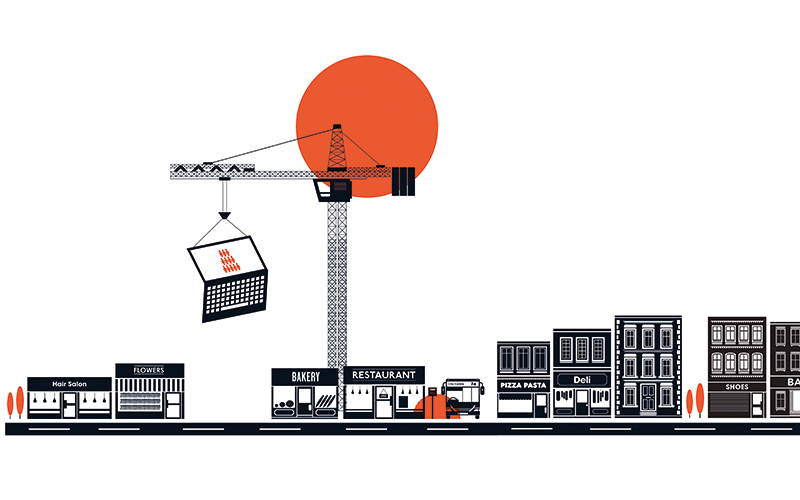
The UK has long been associated with retail as a key part of our culture.
Napoleon famously claimed that the British were ‘a nation of shopkeepers’, and that reputation was bolstered by Margaret Thatcher’s early life above her father’s grocery store in Grantham. TV comedies – including Open All Hours and Desmond’s – celebrated the high street as part of community life.
But then came online shopping, Covid-19 and now the energy crisis. Big names such as department store Debenhams disappeared as debt levels became unsustainable.
Is there a future for the corner shop or clothes store? Can they compete with slick web retailers with lower overheads?
This is a critical issue for the public sector, as business rates are vital for funding services. But the high street is also a central part of placemaking.
According to the Local Government Association, retailing currently accounts for an average of 33% of addresses on high streets – the second highest use after residential, which accounts for an average of 55%.
But the relationship between retailers and local government is often strained. Westminster City Council has been drawn into the row over the Marks & Spencer flagship store on Oxford Street, one of the country’s biggest retail spaces. Plans for its demolition and redevelopment have become a public row, and other store owners are complaining about the tourism offer.
Store owners in the West End are also arguing that they have been hit by the decision to end VAT-free shopping for tourists.
And uncertainty is a problem. Business rates in England, Scotland and Wales have been frozen for the next year. But no decision has been made for Northern Ireland.
Neil Johnston, director of the Northern Ireland Retail Consortium, says: “Businesses need to plan and to budget, and they need to know what is happening with rates. There is more than enough uncertainty around at the moment without this.”
Added to this, consumers are not just becoming savvy on price but are also increasingly concerned about sustainability.
A report by Deloitte says: “When it comes to consumer demographics, we see the topic of sustainability especially high on the agenda for millennials and Generation Z. For Gen Zs, it is their number-one concern. For millennials, it comes just after healthcare and unemployment.”
It adds: “The pandemic has significantly altered consumer sentiment and purchasing behaviour, and there seems to have been a change in consumer consciousness over the past two years, which will continue to shape future shopping patterns.”
Targeted support
So, how do retailers respond? After years of survival, there are plenty of ideas – and people are remaining optimistic.
The consistent theme from the sector is that the government needs to do more than talk. Retail employees, already hit by wage freezes and job insecurity, are feeling the pinch. But the leader of their union isn’t giving up. Paddy Lillis, Usdaw general secretary, wants a level playing field for businesses and for the government to help workers struggling to make ends meet, as, realistically, the industry isn’t strong enough.
He says: “We need an increase in targeted support for low-income households and an end to rip-off prepayment meters. Short-term support with current cost-of-living pressures is crucial, but the chancellor needs to look at lasting solutions, with a new deal for workers.
“The lack of affordable childcare is a huge challenge facing working parents, especially women, in balancing work with caring responsibilities.”
Taxing web firms, an idea being explored in France, is another option. Lillis says: “For many years, the retail sector, particularly the high street, has experienced significant and fundamental challenges. Covid-19 and the cost-of-living crisis have intensified these systemic problems. We were deeply disappointed that the government rejected an online sales tax – which was also supported by many major retailers, and could have been used to fund a reduction in business rates. That terrible decision should be reversed.”
“When it comes to consumer demographics, we see the topic of sustainability especially high on the agenda for millennials and Generation Z. For Gen Zs, it is their number-one concern.”
But physical retail isn’t set to be consigned to history. Business experts say it has some distinct advantages, because humans need connections with others.
Harvard Business School set out to find an economic model that could weather major downturns and the rise of cheaper rivals. It concluded that US motorcycle firm Harley Davidson, founded in 1903, was the best example.
The product isn’t environmentally friendly, and is bought mainly by men. But it has survived thanks to community affiliation. It provides a personal experience to customers, enables them to make the product unique to them and uses its dealerships as a community meeting point.
In-person shopping is not just a US habit. Japan has ridden the wave of technology development, so, in theory, physical shopping there should have declined significantly as online retailing took off.
According to official data, retail sales increased by 3.8% in December last year – beating forecasts and representing the 10th successive month of growth following the Covid-19 slump.
The country currently has 3,124 shopping malls, 52,417 convenience stores and 240 department stores. Neighbourhoods are high-density, so residents, attracted by specialist shops, use shopping as a leisure experience.
The other key to success, according to McKinsey, is not trying to sell to everyone. The consultancy forecast that the luxury market will grow by up to 10% this year, owing to demand from the US and China.
The ideas explain the continued success of independent record shops. Streaming and downloads hit both stores and music labels at the turn of the millennium. But there are now 260 independent record shops across the UK, and Record Store Day draws in thousands of shoppers.
Survive and thrive
ERA, the Digital Entertainment & Retail Association, revealed that last year vinyl outsold CDs for the first time in 35 years. Not only that, music sales topped £2bn – the highest since 2003.
Record-shop-owner Ian Smith says surviving – and now thriving – is down to having a “much better connection” with people who love music.
He says: “There’s much more pleasure to be had in holding a gatefold sleeve, reading the liner notes and just generally engaging with it.”
Creating a great environment to attract consumers is another part of the solution.
The rise of out-of-town retail parks has drawn people away from traditional town centres. But determined town planners and strong regeneration strategies are helping to revive older retail areas. Guidance shared by English Heritage in 2005 became the benchmark for restoring historic centres. It says: “Visitors to historic centres can enjoy the opportunity to shop and linger in an attractive historic environment, and the existence of strong retail and leisure facilities provides an important additional reason to visit. The retail experience in historic centres often forms part of a wider day out or functions as one of a number of linked attractions.”
The latest data shows consumers are voting with their feet – despite the cost-of-living crisis. According to the British Retail Consortium, January 2023 saw total UK footfall increase by 12.5% year on year. High street footfall was up by 20.2%, and shopping centre footfall increased by 12.4%. Retail parks saw a drop over that period of 3.5%.
Helen Dickinson, BRC chief executive, says: “Footfall saw strong growth in January, as employees made more trips into the office and international tourism improved compared with last year. Growth was most pronounced in high streets and shopping centres, as many shoppers sought out a bargain in the sales. Meanwhile, retail parks faltered as the cost-of-living crisis put many shoppers off buying the big-ticket home products often located there.
“The challenge for retailers will be to convert this extra footfall into sales, when many consumers are reining in their discretionary spending.”
Are you being served?
Retail expert Mary Portas has been championing the high street and working with the British Retail Consortium to boost training.
She believes the future of retail is about connecting to consumers’ values of people and planet: “I honestly believe this is the most exciting time I’ve seen for retail in years. Yes, there are challenges. But we are also seeing the best of innovation as new players come to market and older ones reinvent.
“Independent retail is as full of creativity as ever. And more and more retailers understand that the future is not a simple goal of selling stuff, but connecting to the conscious values of people and planet as well as striving for profit. There is so much potential for us to unlearn the old ways and create a new – more beautiful - set of rules.”
Run to stand still
The economic outlook means the sector is going to have to work hard to get cash in the tills.
Andy Sumpter, retail consultant EMEA for Sensormatic Solutions, explains: “The economic outlook is continuing to put inflationary pressures on consumers’ discretionary spend, and, facing inflationary pressures of their own across their manufacturing, supply chain and labour costs, retailers will once again have to run even faster to stand still.”
Back in Oxford Street, Westminster City Council is working to ensure that the nation’s favourite shopping space will get the investment it needs for the future. It’s going to be a complex project.
Geoff Barraclough, lead for planning and economic development, says: “We will shortly be announcing our plans for Oxford Street. In the meantime, we’ve been working with HMRC and the police to tackle the problem of US candy stores selling illegal and counterfeit products, while paying little or no business rates. It’s part of our overall aim to give visitors a much-improved experience.”
He adds: “There’s no time to waste, so we plan to have the Oxford Street work finished by spring 2026.”
Is there a magic formula for a thriving high street? The independent retailers think there is. Smith says: “If you’ve got a bookshop, record shop, a pub and a decent restaurant, you should be relatively happy.”




















